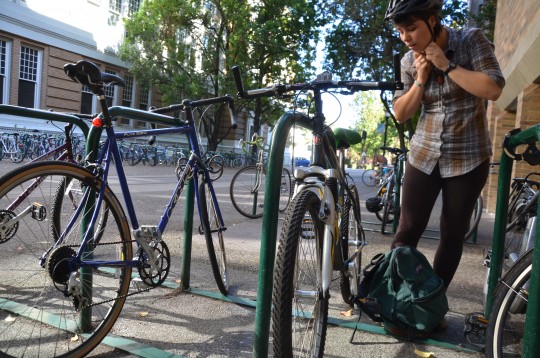
(Photos: M.Andersen/BikePortland)
In a trend that could develop into a huge expense for Portland’s largest school, the number of people biking to Portland’s single most popular bike destination has continued to fall.
“The barrier’s really downtown. They don’t feel safe.”
— Ray Atkinson, vice president of Bike PSU
Last year, for the first time on record, the share of Portland State University employee bike trips to work fell, while student biking continued its plateau after a recent fall.
Estimated student biking rates are down by a third since their 2011 peak, from 12 percent to 8 percent, according to an annual survey conducted by the school each fall. The 8 percent biking rate in 2014 was the same as the rate in 2013.
The student drive-alone rate, meanwhile, has edged from 19 percent up to 20 percent in the same three years even as the student body has grown. If nothing changes, the university could face pressure to spend tens of millions on a new parking garage.
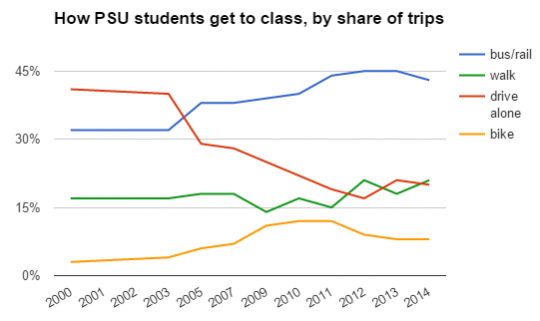
As for PSU employees, the estimated biking rate is down from 15 percent in 2013 to 12 percent in 2014.
The annual surveys ask all employees and a random sample of students to report their main travel mode to work or to their first class on each day of the previous week. The results are expressed above as a share of all trips, meaning that a single person can contribute to multiple categories if she bikes on some days and rides the bus on others. (Not listed here are a variety of less common modes including carpooling, being dropped off, motorcycling and skating.)
Mitigating the apparent bad news about student biking over the last few years is the fact that more PSU students are walking to class, which is related to the 1,000 new on-campus beds that opened in 2012. But though the University Pointe building that opened in 2012 led to a one-time jump in student walking rates, those rates haven’t risen since.
The group of people who bike occasionally to PSU has been on a sharp decline, too. The dark line on this chart shows the percent of PSU students who bike to class at least once a week. It’s down even more sharply since a 2010 peak.
PSU slips backward as other biking indicators rise
PSU’s problems shifting students to bikes seem to be somewhat unique.
The U.S. Census estimates that overall bike commuting in Portland rose in 2014, probably by quite a bit. The city’s recent clipboard bike counts suggest that central-city bike traffic continues to rise and that it’s mostly a decline in bike use in outlying neighborhoods that has been preventing overall growth.
PSU has long seen much more biking than its hilltop neighbor to the south, Oregon Health and Science University. But since OHSU opened an aerial tram in 2006, a free bike valet in 2012 and last month the Tilikum Crossing bridge, bike commuting has grown rapidly, rising 22 percent from September 2013 to September 2015. On Tuesday, OHSU’s Go By Bike Valet reported its highest-ever number of bikes checked in a single day: 363.
Though that figure certainly doesn’t count every bike commuter, OHSU has 14,000 employees and 2,900 students. Bike commuting to OHSU has a long way to go yet.
Portland State University, meanwhile, has improved some things on its own grounds, including pay-to-park bike garages, an on-campus bike shop and an ever-rising supply of free short-term bike racks.
But it hasn’t yet been able to persuade the city to change the streets that lead to and from its campus. There is no dedicated east-west or northbound bike lane in or out of PSU. The only southbound bike lane that leads to PSU, on Broadway, runs through a high-traffic door zone past the doors of several hotels that get heavy taxi and truck traffic.
As we reported last year, the route from the new bridge to PSU’s campus is slow, awkward and uncomfortable to beginner riders.
With Portland-area housing prices rising fast, it’d be reasonable to think that PSU students are living further from their downtown destination. But (at least as of 2013, the last year data was available) more students than ever are actually living within six miles of campus, and not mostly because of the rise in on-campus residents.
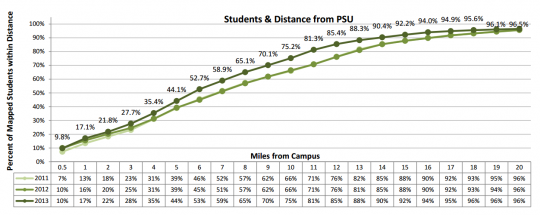
So last week I asked Ray Atkinson, vice president of the recently formed advocacy group Bike PSU, what he heard from fellow students.
“The barrier’s really downtown,” he said. “They don’t feel safe.”
Advertisement
New campus group looks to support biking
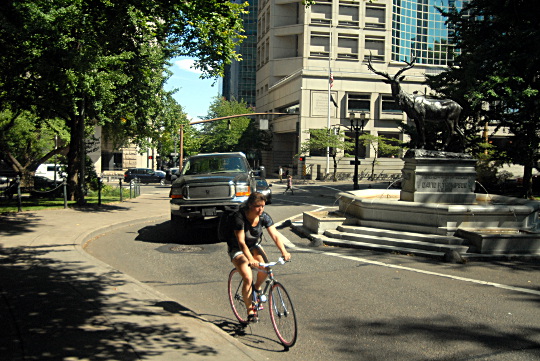
Last week, Atkinson and his Bike PSU co-founder, Gerald Fittipaldi, stood at a table at one of the school’s annual student organization fairs and worked to change PSU’s numbers one bike-commuter at a time.
Propped next to them was a corkboard with a large map of the Portland area. They invited students who came in by bike, or who were interested in doing so, to stick numbered pins in the map to show their location. Atkinson and Fittipaldi are building a database that will let them match people with ride buddies and organize bike trains to help people get used to biking to school.
“We’re over 100!” Atkinson told me when I arrived near the end of their Thursday afternoon shift.
Atkinson is studying for a master’s degree in urban and regional planning. Fittipaldi, Bike PSU’s president, is a graduate civil engineering student. Both had co-founded biking groups at their undergraduate schools and were surprised to learn, when they came to PSU last year, that it didn’t have a student advocacy group of its own. So they started one.
“Instead of going out drinking and dancing, I like to volunteer,” Atkinson explained.
The pair co-founded Bike PSU last April, so this is its first full regular semester as an organization. Atkinson said it’s got about 10 core volunteers. 48 people are part of its Facebook group. It’ll kick off the school year tonight with a “welcome meeting” this evening in PSU’s engineering building, starting to plan the bike trains’ routes.
Why two students don’t bike
Last Thursday I hung out near the Bike PSU table long enough to talk with a couple passers-by about their transportation choices.
“My friend was talking about in Southeast there’s some really cool bike path,” said Avarie Fitzgerald, looking over BikePSU’s map of the city. The fourth-year PSU undergrad who lives on campus but has a friend who lives near Johnson Creek and the Springwater Corridor. Her friend is a nurse at OHSU, she said, and has been talking about biking because “she doesn’t want to become one of those fat nurses. Those were her words.”
Fitzgerald said she hasn’t owned a bike herself since her parents sold her childhood one.
“I’ve wanted one for a while,” she said. “It’s silly to be in the most bikeable city in the world and not own a bike. … I don’t have the money right now.”
Taylor Yocum-Peckham, a third-year student who lives with his wife in Troutdale for the sake of the nature-rich surroundings there, said his schedule is set up so he only has to come to campus two days a week. He usually drives to a MAX park-and-ride in Gresham, but has considered tackling the 90-minute ride downtown sometimes for the sake of the exercise.
“I thought about it during the summer,” he said.
There are a thousand different reasons a person ends up biking or not biking, and some people never will. PSU’s challenge, like every other institution in Portland, is to find the people who can plausibly bike to school and get them to consider it.


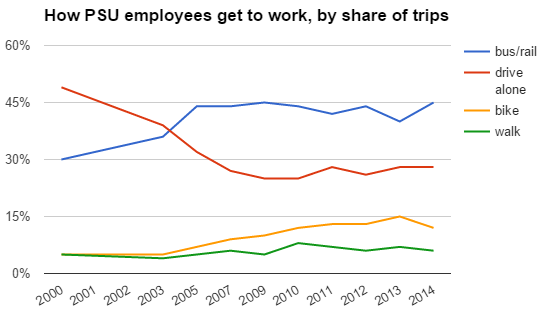
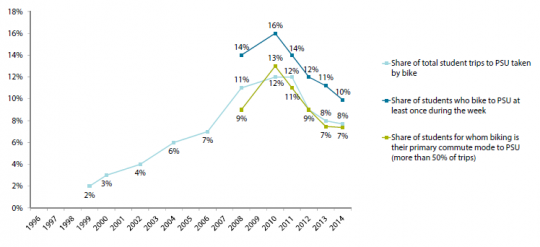
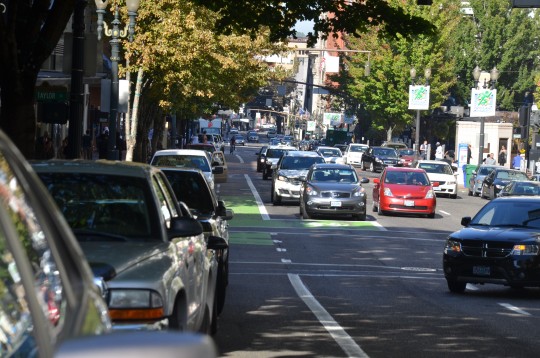
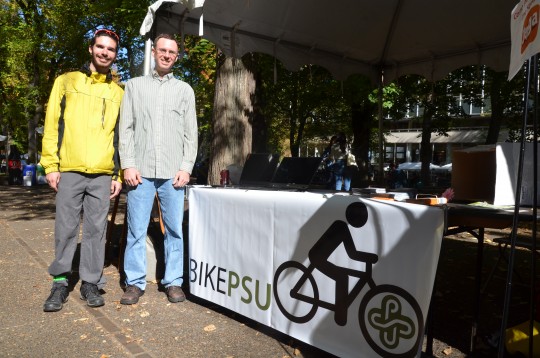
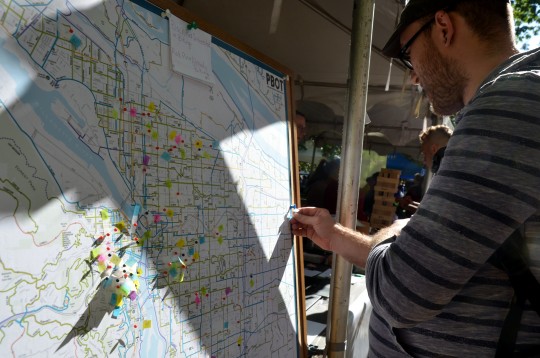
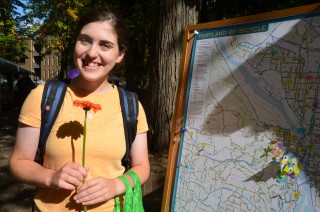
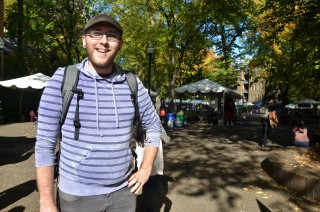
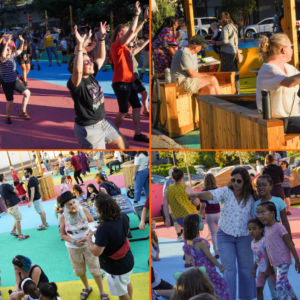
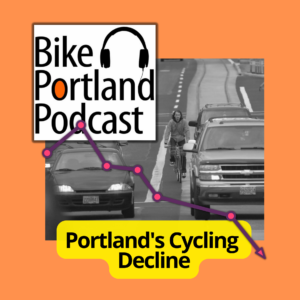
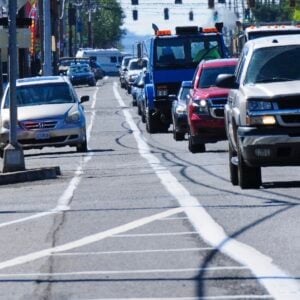

Thanks for reading.
BikePortland has served this community with independent community journalism since 2005. We rely on subscriptions from readers like you to survive. Your financial support is vital in keeping this valuable resource alive and well.
Please subscribe today to strengthen and expand our work.
Car-Free North Park Blocks.
South Park Blocks for PSU, no? But really, north and south for Portland as a whole.
Yep.
Buffered bike lanes from the Hawthorne Bridge all the way to PSU… connecting to the Broadway bike lane and Park Blocks, BUT… we need a buffered bike lane to get BACK from PSU to the Hawthorne Bridge!
I always got stuck in traffic along 4th and my panniers were too wide to squeeze between cars. Its really dangerous to filter through the “meat grinder,” anyway. Half of drivers are on their cell phone watching youtube videos instead of paying attention to traffic.
It is great to see BIKE PSU in action.
Has the administration at PSU ever meaningfully stood behind biking improvements downtown or lobbied city hall / trimet / PBOT to improve bike routes to PSU?
As previously noted, there was a huge missed opportunity when the Tilikum crossing went in under budget without improving bike access from the south waterfront to PSU.
Great question about the PSU leadership SD…
Back in 2008 when PSU Pres Wim Wiewel rode his bike into class for his first day on the job I would have expected to hear more from him about biking.
“…there was a huge missed opportunity when the Tilikum crossing went in under budget without improving bike access from the south waterfront to PSU. …” SD
Got some idea of how many millions of dollars it could cost to create the type of bike access you’re thinking of?
At some point, the city could still design and plan an improvement in access for people biking to the bridge and PSU. The bridge got built. That was the first major step towards providing that access…and it being done under budget likely has made at least some positive impression upon people skeptical of the wisdom of building this unique type of bridge in the first place.
Approximately $5 million. AKA a drop in the bucket of this $1billion+ project.
Was some kind of bike access plan between the two points, other than what’s there now, for that amount of money, already designed, for the Tillikum project, and cut out for reasons other than cost cutting? Some details would be helpful.
To answer your first question, yes — considerably. PSU has been actively lobbying PBOT for improvements to the cycling infrastructure in downtown for several years now. We were active participants in the Bike Plan for 2030, the Broadway cycle track demonstration project, and numerous other efforts throughout the central city. PSU continues to support investment in cycling downtown, from support for Portland Bike Share to the upcoming Central City Safety Improvements Project and the Green Loop concept plan. We are also active in several indirect ways, such as working with stakeholders in the central city to reform parking policy at a substantive level that will set the stage for limiting SOV trips into and increasing in both physical space and funding for bicycle, pedestrian, and transit infrastructure.
As to the South Waterfront and the Tilikum Crossing, PSU actively lobbied TriMet to include bicycle and pedestrian access to the guideway leading from SW Moody to SW Lincoln. This was determined unfeasible by project staff. However, due in large part to our efforts, the project wound up including the connecting Harbor Drive trail between SW Moody and SW Harrison (and on to Waterfront Park). The Orange Line project has definitively improved bicycle access between PSU and South Waterfront.
Thanks for responding to my question, Ian. I would love to hear more about how PSU has backed the development of better bicycle infrastructure downtown and, more importantly, what PSU is currently doing. By “support investment,” do you mean “agree with,” or is it something more substantial?
I would also be interested in the PSU perspective on the obstacles that have prevented adequate cycling infrastructure from happening. As a major stakeholder in down town SW with a vested interest in active transportation, I imagine that the lack of progress has been frustrating for PSU.
With regards to the Orange line “definitely” improving access from the SW waterfront to PSU, I am glad that the Harbor drive trail is there, but this is really a marginal improvement over the route that was previously there.
We are all hopeful that meaningful cycling improvements are coming soon to downtown. It would be great if PSU leadership would publicly advocate for active transportation to PSU and to SW downtown in general.
Does PSU have a bike to school week or offer incentives to staff and students for commuting by bike?
They don’t know why? Really? In America’s Bike Theft Capital?
Raise student parking permit prices? Currently $330-390/term.
That’s only $100/month. Isn’t that a steal in downtown Portland?
Yup, it is. Market rate is at least +50% higher.
PSU conducts a market survey each year to analyze both housing and parking costs in and adjacent to the university district. Our current parking rates are approximately 25-30% below market rate for monthly parking and nearly identical to market rate for hourly & daily parking. It should be noted that PSU has constrained parking supply and begun to convert some of our permit/monthly parking to hourly/daily parking, in effort to meet growing demand for occasional parking. While we recognize that the cost of parking plays an important role in Transportation Demand Management, we are also sensitive to the financial concerns of our students and employees, many of whom are union represented. We have a long history of making incremental increases to parking rates in a manner that balances our costs and goals associated with transportation and the impact to the overall cost of attendance.
Don’t forget to decrease the subsidy for staff parking as well.
There is no “subsidy” for staff parking at PSU. All students, faculty and staff pay the same rates to park on campus.
If they’re not paying market rates for the parking, then it’s being subsidized.
I graduated from psu prior to the millenial influx at PSU. But, I do recall that car permits were less expensive than market rate permits elsewhere in the city. I also recall Motorcycle permits kind of expensive. The funny thing about this graph above is that it doesn’t capture motorcycle commuters. Motorcycling is the next best thing to riding a bike. It seemed to me that psu at the time was ambivalent towards bikes. My permit was something like 60 a term while driving was 300. That didn’t make sense. Plus…covered bike parking was hard to find.
I hope today, psu is charging market rate for permits for driving. Also, they should open their parking structures up to everyone…not jsut students.
Normally, I commute to work after rush hour traffic has dissipated, but this week, I’ve had to arrive at work earlier than normal and have had a chance to experience actually rush hour traffic downtown. I’m a fairly assertive and fast cyclist, but even I find rush hour traffic downtown rather scary. Most cars aren’t moving especially fast due to congestion, but drivers seem extra agitated *because* they aren’t going anywhere fast, and they seem to behave far more erratically. During this time period, a bicycle is by far the fastest way to navigate downtown, especially because you can filter to the front of the line, but you have to be extra cautious in order to avoid getting doored or hooked, having somebody merge on top of you, etc. Unfortunately, the streets just aren’t optimized for bikes.
The protected bike lane on Broadway next to PSU is pretty terrible. Motorists regularly park in it. Students jaywalking across Broadway don’t expect a bike lane on the other side of the park cars, and randomly walk into the lane from between the cars with short notice. Sometimes students stand in the bike lane while waiting for a walk light to cross Broadway, because they don’t perceive bikes as threatening until one is actually on top of them. I’ve actually crashed my bike on that lane to avoid hitting a student who stepped into it with little prior notice.
I like the idea of turning the existing car lane on 5th and 6th into bike boulevards/greenways. It probably wouldn’t work to completely block off car traffic on those streets, given the presence of a couple of parking garages, but perhaps we could make those particular sections limited access while blocking the rest to traffic. (Emergency vehicles could enter via the transit lanes.)
Park Ave would also make for a good multi-directional greenway, if you remove the car parking.
I went to the Downtown Neighborhood Association transportation meeting last month, and the chair was heavily pushing for 5th & 6th Avenues to become the main bike route through Downtown. This would involve completely removing private auto access on those streets, which is apparently seen as an easier political sell than removing an auto lane and/or parking on 3rd & 4th.
At the time I was kind of indifferent about the choice between 3rd/4th and 5th/6th, but now I’m convinced there are some pretty big issues with 5th/6th. One: those streets only have two lanes north of Burnside, which means buses use the left most lane to pass each other. Two: the streetcar runs on 5th between Market and Montgomery. Admittedly there is a narrow bike lane there, but there was talk of making the bike lane wide enough for cargo bikes, and for fast and slow riders to pass each other.
I don’t think those two issues are terrible, although I hadn’t previously considered them. I think 5th and 6th north of Burnside operating as shared bike/bus lanes would be a considerable improvement over current conditions. On 5th between Market and Montgomery, we could keep the configuration as is, minus the private cars, and while it would be the crappiest stretch of the route, it would still be an improvement upon the present situation with cars turning right across your path.
Another point against 5th and 6th would be that you can’t legally turn right from them.
On 3rd and 4th, they could try a one way protected bike lane on each street, or a two-way on one street. The latter would concentrate all cyclists on one street, thereby increasing their visibility. They’d have to do this project correctly using industry best practices though if it’s not to end up worse than what it replaces. I feel that only one out of three experiments in building protected bike lanes in Portland have turned out well (e.g., Moody).
FWIW, I think 3rd and 4th are great candidates for protected bike lanes that flow with traffic. I am, however, pretty strongly opposed to the 2-way protected bike way. This would be difficult to access for the contraflow bikes, every intersection would be dangerous and awkward. Second, people in cars would not be looking for bikes coming from that direction. Finally, this would likely replace a parking lane (8′ wide) or a driving lane (10′-11′). either way, the resulting bike lanes are too narrow, and very difficult to expand.
Moody is not so great, and won’t cope well with growth or new development. It generally lacks intersections but they are all either terrifying or always have a red light when you arrive (or both.) From the south: jug-handle, useless driveway, unused driveway, train crossing, crosswalk. This setup would not be low-stress if it were built downtown with short blocks.
5th and 6th actually have a pretty good advantage of being a good bike route for several reasons:
* very few driveways and curb-cuts, due to the transit mall zoning
* relatively mild grade for biking, more of a constant slope instead of extreme up and downs you will find on Market and Broadway
* goes ALL the way through downtown to the North Park Blocks, easy existing connection to Barbur
* great access to the major employer destinations downtown – Macy’s, downtown mall, Big Pink, Old Town, PSU, etc. Bridges are only a few blocks away, compared to a bike route on say 10th or 14th.
3 words. Bike. Share. Needed.
I was at the Collaborative Life Science Building for a lab over the summer. I could bike to the main campus a bit faster then the streetcar when starting at the same time.
The routes are weird, squished, and clumsy. For example, after you finish the climb from Moody, then you move into the greenbox to keep going uphill along with the streetcar. Then you hit another light-controlled intersection for an even steeper climb or you can try making a left turn. The steeper climb is more direct, and you keep following the tracks to drop off at the book store. But the bikepath vanishes and turns into a two-lane road with some confusion.
It’s very awkward.
Or you can take the safer route with the bikepath which is about 3 or 4 city blocks if you know it’s there. Again there are some weird turns and large swaths of traffic lanes to cross.
x__x
There are variations of that route to get to campus easier or quicker. You can take the Moody separated lane to the multi-use path that runs from Sheridan to Harbor Drive. From there, you can see which way is green: the crosswalk across Harbor Drive or the bike signal across River Parkway (aka Harrison), which gets you to the bike box you mentioned. If you stay on the sidewalk on the other side, however, you can turn left on the path along Natio and go down to Lincoln, where the MAX crosses Naito.
If you want to avoid traffic lights altogether, you can go by the International School and directly onto the Harrison sidewalk (if you don’t mind braving that’s school’s parents in cars).
I had hoped that the Harbor Structure that carries buses and trains from Naito to Moody would include a bike lane, making it instantly the Best Bike Route in America. But it was not to be.
Ah, I missed that Michael had posted all of this and more in the post linked from last year.
Red Electric Trail
PSU is a theft hotspot, so more convenient and secure parking from both that and the elements wouldn’t hurt. You want to come back to a bike, but maybe not spend 15 minutes retrieving it on top of the extra time spent biking. Time is money, many working students have neither, and the reality of tuition is…
There may be new, walkable student housing but just outside of that radius I suspect PSU students are having trouble locating affordable, modest apartments. This was the promise of Portland’s luxury home development boom, but it has yet to bear fruit. Was that seed really planted, or did they just lay down manure?
Well the first thing I noticed in the picture at the top of the article was the glaring absence of U-locks. I see one flimsy cable lock on the left and a set of those handcuff dealies on the right. Not sure how secure those are. Gerald Fittipaldi has gone on record here saying that upwards of 95% of bikes stolen on the PSU campus were not locked with U-locks.
At some point we just need to find a way to get through to people that this is the bare minimum. People don’t lock their cars with twist ties and expect the miscreants not to notice.
Once we’ve gotten the secure locking procedure taken care of (and I suspect the theft problem takes a nosedive) we can and should look at the other dimensions of the problem (secure parking, registration, enforcement, etc.)
Getting serious about locks is one thing, but some places I simply won’t risk anything but my “beater” bike. I am lucky to have a bike considered expendable. Many do not.
Sure I get that.
“I am lucky to have a bike considered expendable. Many do not.”
Coming to terms with the value of an unflashy bike is something worth exploring a bit more, I think. I would agree that life with a bike that might not fetch that much on the street is a lot easier. Part of what I was trying to suggest in my article here recently was that it is less difficult, expensive, onerous to acquire and maintain a serviceable bike for transport than many people (perhaps) believe. I don’t think of my bike as expendable, but it was cheap, and I could replace it without breaking the bank.
Honestly, most students aren’t riding around a $2k FELT either. But even if you have a beater and don’t lock it properly… if it gets stolen, most students won’t bother replacing it. Ironically, I saved over $1,200/year at PSU by biking… enough to afford a really nice bike or to save up.
(I’ve had the masterlock street cuffs for…10 years +? Park everywhere in Portland–downtown & SE the most, but also North and NE–and they’ve kept my bike safe. Have noticed evidence of tampering at the locks, too–as though thieves have tried. Maybe I’ve just been lucky, but that’s my experience, for what it’s worth)
p.s…I got them after a previous bike was stolen. er…cough…cable locked, but in what I thought was a secure building/garage w/ cameras and a multiple security guards.
We actually are better off than many places in town as far as bike theft goes. We’ve made significant strides in reducing it with education as well as restricting locks sales to only include u-locks at the Bike Hub. While it is not perfect by any means it is not nearly as bad as it once was. Add to that the availability of secure, access controlled bike parking at it really isn’t a bad place to commute to.
Who would want to park their bike in a bike theft hot spot, only to have their bike stolen and dismantled in the many chop shop camps that the city openly tolerates?
Rent prices anyone? More expensive to live close in to the campus. More students will be living further out and using cars or TriMet to get to classes.
As the article says, the opposite is happening. More students are living closer to campus than they were before.
My guess is that things are one step more complicated: the students (and employees) who can afford to live close to campus are more likely than they once were to be rich enough to not blink at the parking permit prices.
I am curious about whether the wealth profile of the PSU student body has shifted since 2010.
Those graphs show that more people are taking transit instead of biking. No need to build a parking garage. Constrained parking supply will induce demand for other modes anyway.
I know this is the bike forum but you’ve lost the forest for the trees. The first thing I read on the graphs is HOORAY! Car use to campus is down, transit is way up! That bike use dips just slightly is a minor point of those graphs. I think they are terrific news. Billions have been spent to make downtown a transit hub – its working!!!!! And this was before the Orange Line.
Students have busy complicated days with jobs, classes, and other responsibilities. They may not be a great target audience for biking.
Honestly, we should just be comparing car to non-car modes. If more people are taking public transport instead of driving, that’s still a good thing!
Downtown motorvehicle congestion definitely seems to be getting worse over the past few years so it’s no wonder that PSU bike commuting has fallen off a cliff. I’ve also noticed increased hostility from drivers. For example, some people appear to be intentionally driving close to parked cars in order to block people cycling from filtering forward. Few people enjoy riding in dense stressed-out motor vehicle traffic.
I also agree with chris that the broadway cycletrack is stressful due to pedestrian traffic and parked vehicles.
Minor correction:
A tiny fraction of OHSU’s bike commuters use the Go By Bike Valet. I’ve personally never used it.
Hear, hear.
That’s fair. Do you park elsewhere at the base of the tram, or tackle the hill? Any idea how many bikes wind up on top?
The racks and key-card facilities at the sowa and on the hill are heavily used. Moreover, I and many others store their bikes in work-space or offices. I got in the habit of riding up the hill a long time ago so I only use the tram a few times a year.
forgot to add that many ohsu staff bike from the sw.
In addition, a lot of us are based in the South Waterfront (and elsewhere in the city) and only head up the hill occasionally.
Some of us also take our bikes up on the tram.
Biking up the hill just gets me way too sweaty, and I’m only up there an hour a week.
I for one don’t feel comfortable leaving my bike locked on campus for very long. I live in this area and I bring my bike to bed each night
PSU just built a whole bunch of housing. I would think that would provoke a bump in the bike commute numbers.
No, it would be more likely to provoke a bump in the pedestrian numbers. If the destination is ten blocks away or less, most people won’t bother with biking.
sorry for my wording…that’s exactly the point i was trying to make
That’s true (and it’s noted in the post), but it doesn’t explain the fact that the number of occasional bikers started falling in 2010, or that the number of employee bikers seems to be falling now.
Bike thefts and bad connections. Really, it’s not that hard to fix. Make the drivers pay more to fund better infrastructure for people biking.
Sellwood Bridge expected to be done in February / March 2015.
Others have mentioned the lack of decent parking for bikes (theft, exposure to weather) and the horrendous approaches to the south park blocks- all good points and true. The new housing is almost exclusively occupied by foreign (Japanese) students. They go nowhere and do nothing aside from go to class. Taking a bike from the dorm to Lincoln Hall takes twice as long as walking.
The elephant in the room is the composition of the student body- sedentary millennials during the day and adults coming from their day jobs in the evening. As for the former, if you expect people who’ve never exercised a day in their life to run the downtown door guantlet in the rain, you’re setting yourself up for disappointment. As for the latter, nothing like getting out of class at 9PM and trying to make it home in one piece on your bike by 10 PM so you can roll out of bed the next day and do it again.
I’d be curious to know whether anyone at PSU has availed themselves of what surely must be an internal email system to send out a PSA regarding proper bike locking etiquette? You know, a quick always use a reputable U-lock to lock a wheel and the frame to a stationary object, and here’s where you can get a good U-lock kind of missive. Seems like an easy start. Or perhaps it has already been done?
I remember sometime in the later half of the first decade of the 2000s, someone(s) place stickers on many of the bike staples around the PSU campus visually demonstrating this method of bike locking. 2006-ish? I haven’t been around the campus lately so I can’t say if they’re still around and/or present on the huge expansion of new staples that occurred later.
PSU does a great job with of encouraging u-locks. The stickers you speak of are on most, if not all, of the bike racks. Students can purchase reduced price u-locks at the Bike Hub. Very few of the bikes stolen on campus were locked with u-locks. I feel people have a distorted view of the theft risk when using a good u-lock. Cable locks? That’s a different story.
p.s…I got them after a previous bike was stolen. er…cough…cable locked, but in what I thought was a secure building/garage w/ cameras and a multiple security guards.
that was supposed to go up under my earlier comment about the street cuff locks. oops?
Kids these days are lazier? 🙂
I have never had any issues leaving my bike parked at PSU and most of my classes are at night. There are many wet lit racks and one placed under a skyway that is protected from the elements.
wet = well
Oops. wet > well
The decline in biking is a reflection of the current economy. Campus housing is full. Very few others can afford to live within a reasonable distance for bike commuting.
As a regular MAX Orange Line commuter, I see many southbound trains fill up to standing room only at PSU. Most of these people ride the line all the way to the end and then transfer to a bus that takes them even further south.
You mean, aside from the noise and pollution. Personally, I would much rather share a street with a car than with most motorcycles.
Live in the ‘burbs due to more affordable rents out yonder?
Have to work a job or two whilst going to school?
Need to be at said job less than an hour after class lets out?
After work, your class study group meets at an apartment out in Tigard?
Historically, PSU students are by and large commuter students. There are very few traditional “live on campus” students there. I strongly suspect that a lot of folks going to school there are working to avoid huge amounts of borrowing, raising families, and taking a mix of morning and evening classes like I did during my time there. With time constraints and distances to cover, driving and mass transit are probably more time efficient and comfortable despite the costs.
I rode my bicycle for a little while after being hit by a car on my motorcycle. It really opened my eyes to how much more dangerous riding a bike was over riding a motorcycle. If the city would get serious about bike routes through the city without cars….numbers would increase.
To what another said about having two different kinds of students, it’s true. A person taking night classes isn’t going to generally ride a bike. Plus, with night classes it’s super easy to find a parking spot and (At that time) nobody was patrolling looking for parking passes.
I commuted to PSU for a few years during grad school (2008-2012) and this was my experience. Note that these were night classes (6-9pm). I live in Hollywood, a 10min walk from MAX. I am a confident urban cyclist.
I started with a mix of driving and transit. Sometimes I would have to drive downtown right after work. I would park on the street and just pay an hour or two (free after 7pm). If I had more time, I would go home first and then take MAX.
I decided to try riding instead of taking MAX, but I did not want my nice road bike to get stolen, so I paid the fee for secure bike parking. My preferred route was to ride the Hawthorne, and then take 1st south to Lincoln. Bike lanes the whole way, and no killer grade to climb. I realize this route only works for people going further south on campus.
After a few months of paying for secure parking, I decided to just buy a cheap single speed and lock it up outside. Biking was faster and cheaper than transit. Cheaper than driving.
What I believe would improve bike commuting rates:
1. Raise the price of parking garages. It will also help if the City extends paid parking hours past 7pm.
2. Use the proceeds from increased car parking fees to make secure bike parking more available and cheaper.
3. Improve connections from the Hawthorne to 5th/6th and the park blocks. Make 5th and 6th or the park blocks into safe biking routes. Either close the park blocks to cars or close 5th and 6th to cars.
“Improve connections from the Hawthorne to 5th/6th and the park blocks.”
Oh heck yeah.
Getting dumped off the Hawthorne at 1st & Main is a harrowing experience even for seasoned bike commuters.
The connections from S. Waterfront/Tilikum are a hassle too…as Justin Carinci points out above, you do better by avoiding the official wayfinding
“…Either close the park blocks to cars or close 5th and 6th to cars.” Chris I
If you’re thinking to entirely exclude travel on Park and 9th streets adjoining the park blocks, to cars, or all motor vehicles, that’s an idea that doesn’t seem likely to happen.
Quite a few years back, when the city was trying to enhance the quality of experience the park could offer people visiting the park, curb parking directly next to the park was eliminated; only parking on the curb across the street was available. Eliminating the parking directly next to the park, helped a lot.
Effectively, it widened the street width usable for travel, meaning people traveling by bike had greater distance from parked motor vehicles, and no vehicle doors on their left side to worry about. It was better for people on foot, crossing the street, as well. Not having a wall of motor vehicles directly next to the park, vastly improved the look and feel of the park. Of course, there was less parking revenue for the city.
FWIW, I think 3rd and 4th are great candidates for protected bike lanes that flow with traffic. I am, however, pretty strongly opposed to the 2-way protected bike way. This would be difficult to access for the contraflow bikes, every intersection would be dangerous and awkward. Second, people in cars would not be looking for bikes coming from that direction. Finally, this would likely replace a parking lane (8′ wide) or a driving lane (10′-11′). either way, the resulting bike lanes are too narrow, and very difficult to expand.
I just took a closer look at the broadway bike lane with google. It’s a great effort but poor execution. I wouldn’t want to ride in it either.
As for parking why not just set up a bike 24 hour valet or two for the campus. Staff it with students on financial aid packages, offer it free to students and faculty as part of tuition, charge non students/faculty for the service (ie put on right on or next to the trolley line for a downtown bicycl park and ride kind of thing). You could even toss in basic maintenance package (pump tires, oil chain etc) for a small fee too in order to offset the costs.
Done right it could likely turn a profit pretty quickly.
They already have secure parking.
https://www.pdx.edu/transportation/indoor-bike-parking
@lop is correct in that there is a significant amount of secure bicycle parking available on campus. We currently have seven facilities with 361 spaces and over 600 active users. The charge for usage is $45/year. We’ve found this to be the best solution for our students needs as we have both residents and commuters. This makes something like a bike valet less viable because the bike garages function as both short and long term storage.
Besides percentages only, I’m curious about the raw numbers, i.e. from what total population is each year’s percentages calculated?
Do actual counts for bikes remain flat, or grow, even if the percentage of a greater total fell?
Do most new students/staff choose to walk?
Besides percentages only, I’m curious about the raw numbers, i.e. from what total population is each year’s percentages calculated?
Do actual counts for bikes remain flat, or grow, even if the percentage of a greater total fell?
Do most new students/staff choose to walk?
I graduated from PSU in 2001, returning to the campus after 14-year hiatus. I commuted daily by bicycle from my home near Jefferson HS, when bicycle infrastructure was a lot less, um, structured; and, more importantly, Portland’s population was significantly smaller.
Based on the growth in Portland’s car-driving population, the increase in auto traffic in inner N/NE Portland, and my current location (farther north, near Woodlawn Park), I seriously doubt I’d ride to class every day if I were a student now. The fact is that, along with growth, it’s gotten a lot more dicey to ride a bicycle in downtown Portland and these days I tend to go multi-modal (bicycle-bus) a lot more frequently.
I wonder also if the rise in housing and living costs hasn’t made it harder for some students to live close-in enough for bicycling to make sense.
Back in the day, riding your bicycle to/from school might have meant a round trip of less than five miles; then it grew to ten or more; and these days, we hear a lot about hard-core commuters who pedal in excess of twenty-five miles to get to school or work. That’s not commuting to me — that’s practically a training ride. I don’t ride to train for anything anymore, and I would like to live again in a city where shorter distance commutes still feel reasonable, doable and safe. Maybe I’m dreaming.
>Back in the day, riding your bicycle to/from school might have meant a round trip of less than five miles
The survey pdf linked at the top of the article gives a median distance by mode. For bike to PSU trips by students the median distance is 2.57 miles, for employees it’s 3.16 miles. Over the last couple years they’ve said the share of the student population living that close has increased.
>these days, we hear a lot about hard-core commuters who pedal in excess of twenty-five miles to get to school or work.
While true I think that’s more of a statement about the tilt of the ‘bike media’, this site included, than it’s reflective of the typical trip taken by a person on a bicycle.
Lies, damn lies, and surveys. Oy. I feel like it’s important not to read too much into these numbers, as for one thing, the changes in recent years to mode split is relatively insignificant if compared, for example, to the 2003-2005 period. There are many potential explanations for the variations we see from recent years – changing student body demographic, regional weather patterns, or even just chance. There are certainly things that could be done to encourage more people to ride to campus, such as better security, but frankly I think this is more the responsibility of the city as far as infrastructure changes go. My eyes do not perceive any noteworthy trends here.
Yes. If drive alone numbers haven’t really changed is this all a big deal?
Hmm. Well, personally I have only biked and ridden the new Orange MAX line to PSU this year. Far better options than driving, unless I’m carting bulky materials to campus!
Many more people would drive to campus if they added parking garages, from what colleagues have told me in the past.
Has anyone put a graph of the price of gasoline on top of the graphs for bike usage? That could be one factor.
I’d rather ride on the sidewalk than in the street in that one picture of the woman with the large truck coming up behind her. She’s not in a marked bike lane. Perhaps if streets/bike lanes approaching campus are not safe, the city could allow cyclists to ride on the sidewalks of some streets – would need to ride max 5 mph if peds might cross your path from adjacent doorways, etc.
Covered parking would be helpful on rainy days.
Are showers available on campus for cyclists? Longer distance riders would want them. Have at least one coed shower facility and cycling will skyrocket. Same with enrollment.
🙂
We spoke during our meeting tonight about the horrible cycling infrastructure to and from PSU. We’d like to see some of that $60MM budget for improving the infrastructure put towards creating a north/south greenway (although with such a small budget I don’t have much hope of more than some painting and maybe signage). The Park blocks sound like a great idea but there are stop signs along those routes at almost EVERY intersection so I don’t think this would be feasible. I’d like to see the transit corridors on 5th and 6th turned into a shared road for public transit and bikes only. There’s only one driving lane on that road plus there’s already the stop light system in place, it doesn’t seem like it would be too hard to do that. We’d also like to see Naito improved with either raised bike lanes or protected lanes that extend to and from the bridges as well.
Additionally, I’d love to see the parking garages in the area with better warning for exiting cars on one way streets. Motorists only look in the direction of the oncoming traffic and don’t see the bike directly in front of their car. This systems needs to be improved.
Why did the responsible parties build a viaduct alongside the rails and busway for bikes and pedestrians?
It might be helpful if PSU’s top leadership was a little more vocal in their advocacy for safe streets for students and employees.
Consider for example the case of SW Barbur, when Lewis and Clark’s leadership spoke out[1] but PSU President Wim Wiewel did not.
Wiewel is a pretty nice guy, and looked pretty great in that team jersey we gave him for that one bike commute to PSU seven years ago, but it’d be pretty nice if he biked in a bit more regularly and knew of the dangers that students and employees regularly face on streets like Barbur (or any street downtown, for that matter).
Jonathan or Michael, I’d love to hear if President Wiewel has biked much since then, from his posh PSU-provided mansion in the hills down to campus, and what he’s been doing lately to push for safer infrastructure for the PSU population getting in and out of downtown. (Or maybe, since Hales likes biking so much these days, you could point out to him that the last mayor got a morning ride in with Wiewel and perhaps now he should as well.)
1: http://bikeportland.org/2013/09/27/in-letter-to-transpo-officials-lewis-and-clark-college-president-urges-action-on-sw-barbur-94650
Used to be just a 5 mile radius was too expensive to rent a place in, now it’s an 8 mile + radius. Every mile reduces bike commutes.
Too many streets with rails in them down there these days. No one likes riding bikes on Streetcar roads. Of course all that new rail is encouraging more transit.
I’d bet rising rents have something to do with this. The closer you live to PSU, the more expensive it is. If you’re on a student budget you may have to live further away than you would have just a few years ago, so you’re less likely to ride from further away.
I’ve been riding my bike to PSU for one reason or another for the past 20 years, usually from NW Portland. I’m a slow rider and usually pick the quiet streets and thread my way thru the park blocks. I have to say, in the past 2 years I have seen the numbers of homeless people in the park blocks skyrocket. They’ve become much more aggressive (blatent drug dealing, heckling, glaring at you & then stepping into the street right out in front of you). And, I swear, everytime I start to lock up my (cheap!) bike, someone says, “Double lock!” and “Lotta bike theft here!” And you wonder why the numbers are falling? Any breakdown as to gender or age bracket? I know several women who won’t even GO through the park blocks now, much less bring their bike!
PSU isn’t alone in Oregon in seeing marked declines in bike use. At the south end of the Willamette Valley sits Eugene, which has gone from 10.8% bike use in 2009 to 6,8% in 2014, a 38% decline according to the ACS.
Perhaps unexpectedly to BikePortlanders, Eugene has added bike lanes, put in many bike lane buffers, a few bike-specific traffic lights and even some cycletrack in that time frame. Unfortunately, it didn’t fix its mostly door-zone bike lanes (and the buffers on the traffic side made them worse).
Perhaps increasing motorist traffic coupled with a lack of law enforcement and poor facilities (door zone bike lanes are the worst of poor facilities in my opinion because of the expectation that cyclists will ride in a dangerous location) are bound to cause decreased cycling participation. How many blocks of “good” infra does it take to balance a block, or part of a block, of crappy infra?
How real is that decline? 2009 was a big jump from the surrounding years, the 2014 number is a 30% jump over 2006. Bike commute rate according to the 1 and 5 year ACS with margin of error for Eugene city, Oregon.
1 Year
2014 6.8 +/- 1.4
2013 7.6 +/- 1.5
2012 8.7 +/- 1.7
2011 7.3 +/- 1.6
2010 8.3 +/- 1.8
2009 10.8 +/- 2.3
2008 8.0 +/- 1.7
2007 8.5 +/- 2.1
2006 5.2 +/- 1.4
2005 8.4 +/- 2.1
5 Year
2013 8.4 +/- 0.8
2012 8.7 +/- 0.9
2011 8.8 +/- 0.8
2010 8.2 +/- 0.8
2009 8.2 +/- 0.9
Looks like cheap gas in 2014 + high stock market makes people feel rich so they drive cars. No jobs in 2009 + low stock market makes people feel poor so they bike. Looks like something wrong with 2006 data – could be similar problem in 2014, maybe bad data.